Transparent, Translucent and Opaque and Color Addition/Subtraction
0.0(0)
Card Sorting
1/26
Earn XP
Description and Tags
Study Analytics
Name | Mastery | Learn | Test | Matching | Spaced |
|---|
No study sessions yet.
27 Terms
1
New cards
What is transmission?
The passing of light through matter. All of the light that reaches your eyes is transmitted through air.
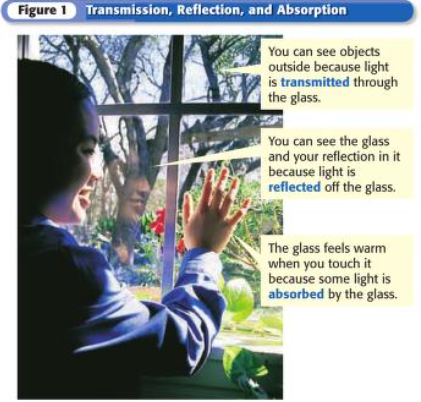
2
New cards
What does transparent mean?
Matter through which visible light is easily transmitted is said to be transparent. Air, glass, and water are examples.
3
New cards
What does translucent mean?
Translucent matter transmits light but also scatters the light as it passes through the matter, but does not let the light travel straight through. Wax paper is an example.
4
New cards
What does opaque mean?
Matter that does not transmit any light is said to be opaque. Instead, they reflect light, absorb light, or both. You cannot see through opaque objects. A book is an example.
5
New cards
What is absorption?
The transfer of light energy to matter. When light enters a material but does not leave it, it is absorbed.
6
New cards
What is reflection?
The bouncing of light off a surface.
You see an object only when light from the object enters your eye. However, most objects do not give off, or emit, light. Instead, light bounces off the object’s surface.
You see an object only when light from the object enters your eye. However, most objects do not give off, or emit, light. Instead, light bounces off the object’s surface.
7
New cards
What happens when light strikes a rough surface? (ex: wood, cloth)
the light reflects in many different directions. Some of the reflected light reaches your eyes, and you see the object.
8
New cards
What happens when light touches a mirror?
Light bounces at an angle equal to the angle at which it hit the surface. when light strikes a smooth or shiny surface (a mirror), it reflects in a uniform way. The mirror produces an image. Light from a lamp might be reflected by your skin, then be reflected by a mirror, and enter your eye.
9
New cards
How is an object’s color determined?
Humans see different wavelengths of light as different colors. Humans see long wavelengths as red and short wavelengths as violet. Colors like pink and brow are a combination. This means that the color that an object appears to be is determined by the wavelengths of light from the object that reach your eyes.
Light reaches your eyes after being reflected off an object or after being transmitted through an object. Your eyes then receive the light and your brain interprets them as colors.
Light reaches your eyes after being reflected off an object or after being transmitted through an object. Your eyes then receive the light and your brain interprets them as colors.
10
New cards
What happens when white light strikes a colored opaque object? (do not confuse white light with the color white)
Some colors of light are absorbed while some are reflected. Only the light that is reflected reaches your eyes and is detected. The colors of light that are reflected by an opaque object determine the color you see.
11
New cards
Is it possible that some matter can absorb visible light but let other kinds of electromagnetic waves through?
YESSSSS!!!! Radio waves can pass through walls that are opaque to visible light. X rays pass through skin and muscle, but are stopped by denser bone.
12
New cards
Can the perceived color of an object depend on the light available in the area?
YESSSSS!!!! Use a red light bulb as an example. The glass around the bulb filters out all colors except red and some orange and yellow. An object that reflects red light would still appear red under that light bulb. But an object that absorbed all red, orange, and yellow light would appear gray/black because we can’t see colors of light that aren’t even being reflected!
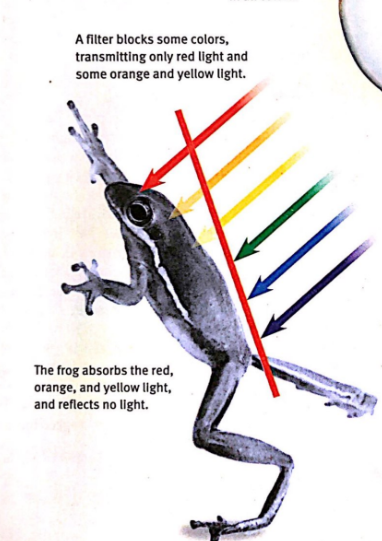
13
New cards
What happens to light when it passes through matter?
Light travels slower in a medium than in a vacuum. When light enters a medium from a vacuum, shorter wavelengths are slowed more than longer wavelengths. In a medium, the speed of violet light is less than the speed of red light,.
14
New cards
What is refraction?
The change in direction of a wave as it passes from one medium into another at an angle.
Your brain always interprets light as traveling in a straight line. By looking at the picture, you perceive the straw where it would be if light traveled in a straight line. The light reflected by the straw in air does travel in a straight line to your eye. But the light from the lower part of the straw changes direction when it passes into air. It refracts, causing the illusion that the bottom part of the straw in a water glass is disconnected from the top part.
Your brain always interprets light as traveling in a straight line. By looking at the picture, you perceive the straw where it would be if light traveled in a straight line. The light reflected by the straw in air does travel in a straight line to your eye. But the light from the lower part of the straw changes direction when it passes into air. It refracts, causing the illusion that the bottom part of the straw in a water glass is disconnected from the top part.
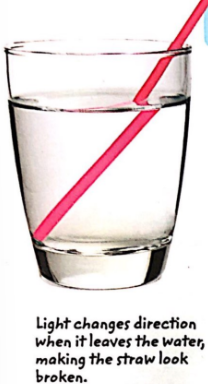
15
New cards
What happens when light strikes a white object?
all colors are reflected
16
New cards
What happens when light strikes a black object?
all colors are absorbed
17
New cards
What colors of light are reflected and absorbed when they hit a strawberry?
Red light is reflected while orange, yellow, green, blue and purple are absorbed.
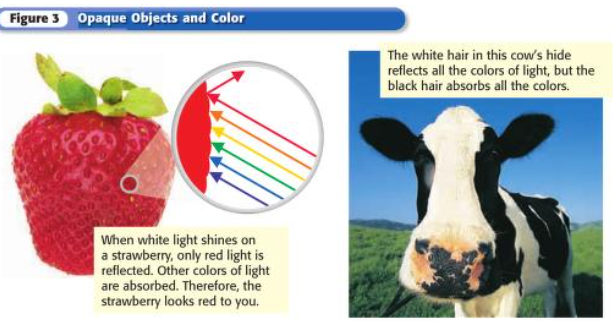
18
New cards
If you had a green translucent/transparent bottle, what is absorbed and what is reflected?
When you look through colored transparent or translucent objects, you dee the color of light that was transmitted through the material. The other colors were absorbed. So, green would be reflected from the bottle.
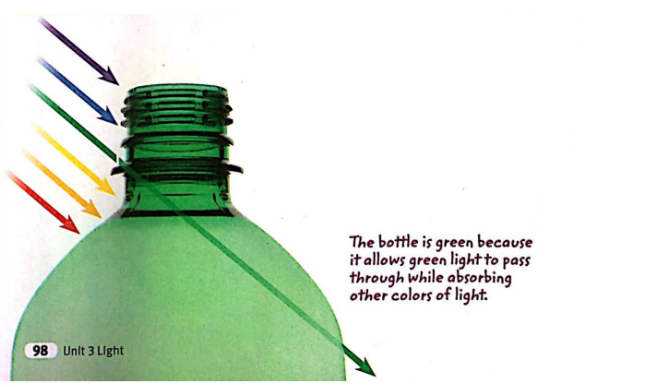
19
New cards
Why is ordinary window glass colorless in white light?
It transmits all the colors that strike it.
20
New cards
How can you get white light without adding all of the colors of light together?
You can get white light by adding just three colors together- red, blue, and green. These colors can be combined to produce many other colors. These colors are called the primary colors of light.
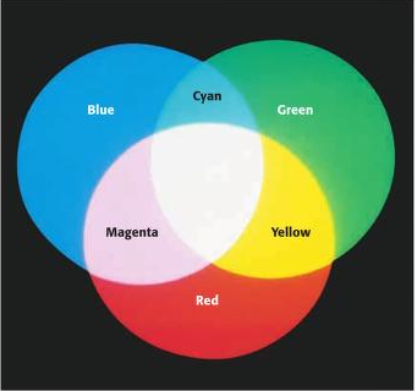
21
New cards
What is color addition?
Color addition is when you combine colors of light.
When two primary colors of light are added together, you see a secondary color of light. The secondary colors of light are cyan (blue + green), magenta (blue + red), and yellow (red + green).
When two primary colors of light are added together, you see a secondary color of light. The secondary colors of light are cyan (blue + green), magenta (blue + red), and yellow (red + green).
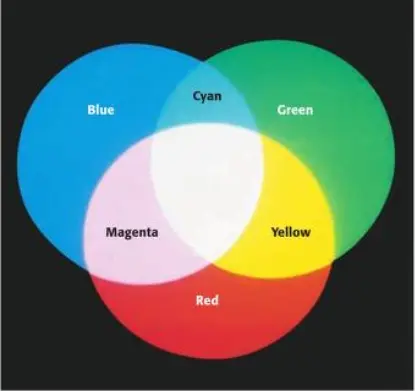
22
New cards
What is pigment?
A material that gives substance its color by absorbing some colors of light and reflecting others.
23
New cards
What is color subtraction?
Mixing pigments is color subtraction. Each pigment absorbs at least one color of light. When you mix pigments together, more colors of light are absorbed or taken away.
The primary pigments are yellow, cyan, and magenta. They can be combined to produce any other color, including black.
The primary pigments are yellow, cyan, and magenta. They can be combined to produce any other color, including black.
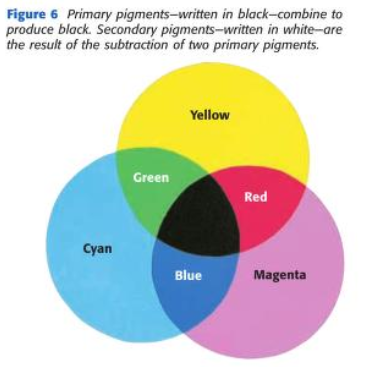
24
New cards
Name and describe three different ways light interacts with matter.
light reflects off matter, shines through matter, and light makes matter hot/warm
25
New cards

c. transparent
26
New cards
what happens to the different colors of light when white light shines on an opaque, violet color
Violet is reflected while all other colors are absorbed.
27
New cards
Explain why mixing colors of light is called color addition but mixing pigments is called color subtraction
The combination of colors of light is called color addition, when 2 primary colors are combined, you see a secondary color of light so you “add” them together. Color subtraction is when you mix two pigments, so they each "subtract" the colors of light they do not reflect.